An analysis of what good posture is and how to correct common problems. Part one
Posture - What is good posture?
Posture, its not a very cool or sexy topic to talk about or learn about but its crucial for good health, optimum athletic performance and preventing injuries.
Its something that needs regular reassessment and monitoring. Its good to check in a number of times a day with your body and see what your various joints are doing and if everything is correctly aligned.
Notice the people around you, how many of them have bad posture. Rounded shoulders, hunchbacks, forward head carriage, anterior tilt of the hips, slumped or collapsed in the chest, a sway back, knock knees or duck feet. stance. When you start looking around you realise its epidemic and it starts often in early childhood and the severe consequences we see in older people who haven’t paid attention, where it becomes a permanent and debilitating factor that hinders everyday tasks and causes much pain. This can all be avoided with regular corrective exercises and consciously correcting yourself.
Understanding posture.
If we drew a straight line down the middle of the body when you are standing straight and if we flipped one half on top of the other there should be perfect symmetry.
Feet - The feet should be straight and facing forward and parallel to each other and not facing inwards or outwards.
Knees - should also be pointing straight ahead so they can bend and track in the direction they are supposed to go in, not facing outward or collapsing in.
Hips - should be level, not one hip higher than the other which can lead to many problems from back to hip to knee pain and ankle pain. The hips are also not be tilted forward or backward but be in a neutral position. Picture you hips as a bucket of water and if you are tilted forward water will tip out of the bucket or if you tilt backward it will tip out the back. The hips should be neutral so the water stays in the bucket for this analogy
Shoulders - should be level, not one higher than the other and not twisted forward. Rotational forces and asymmetrical forces can otherwise limit your mobility and strength.
Arms - should hang correctly. Things and index finger should be straight forward. If you have shoulder muscles that are too tight you will often get rotations forces (hunched shoulders) and that in turns turns the hands so you get the gorilla hand look with the back of the hands facing forward.
FROM THE SIDE VIEW
If standing correctly the line should go from the ankle to the centre of the knee to the hips and up to the shoulder and then to the ear, all in a straight line. This means gravity is pulling down through the major load bearing joints efficiently.
If anything is shifted out of position other muscles and joints have to compensate for the lack of alignment and have to work overtime. Just one area out of alignment will negatively affect the whole body in a knock on effect. Muscles will shorten and lengthen in the wrong places. Your bodys’ natural shock absorbers wont be working correctly.
The static posture positions will influence you in your training and translate into the correct loading when exercising, helping you to avoid injuries.
So you must get your posture correct statically first to make sure you are then moving correctly during training and then continue with good form during your exercises.
Because we tend to spend so much time sitting nowadays, many people have very poor posture and our mobility programmes at Running Hot coaching are designed to loosen these chronically shortened muscles and strengthen and shorten overstretched ones.
We need to be aware throughout the day during our routine activities, of our postural alignment. Check it while sitting, while waiting in queues etc.
CORRECTIVE EXERCISES TO IMPROVE POSTURE.
Forward head posture and upper cross syndrome.
Because we are often hunched over desks and computers all day many people have the forward head posture and upper cross syndrome. Upper crossed syndrome is where you tight sub occipital, upper traps and pectorals and weak neck flexor, rhomboids and lower traps. Some muscles are too tight and others are overstretched in other words.
To restore posture and alignment.turn side on and take a photograph of your self, now draw a straight line up from your middle shoulder to your middle ear. The shoulder and ear should be in alignment if the ear if forward you have a forward posture and if the shoulders are hunched and rotated inwards as well, then you have upper cross syndrome i.e. upper back is rounded and the shoulders have dropped forward and are internally roasted.
The exercises
Stand with your back to the wall
contract shoulder blades back, head up against the wall. Don’t look up, keep head level.
Now draw chin in and down. Walk your feet out from the wall about a foot, make sure ear is in alignment with the shoulder if not draw chine in. Upper back is now slightly off the wall. Now hold this position for three minutes to strengthen and length the right muscles.
To be continued in part two with more corrective exercises.
